A rustic pie made from tender pigeons, cooked until the meat is forked tender and made into a thick, rich filling. If you're looking for a pigeon recipe that uses a number of birds, this is for you.
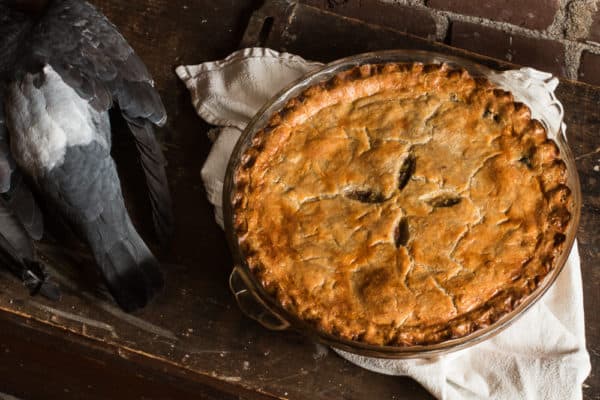
I talked to a hunter last year and told him I was excited to harvest pigeons. He laughed, looked at me like I was idiot, and told me he shoots them and throws them in the woods as they're not worth eating. I kept my mouth shut.
Now, I've never really been a hunter, spending so many years in the kitchen, but I learned about eating pigeon by reading about great chefs cooking squab, so I've never really considered it garbage, or a worthless harvest--just the opposite. I also think there's something to be said for eating what you kill.
This year, I've been hunting pigeons occasionally, and it's a blast, or maybe I should say a plink. I can't remember where it started, but I'd been talking about hunting squirrels out of my Grandma's bathroom window as they ransack her birdfeeder, and varmint control must have come up around the dinner table sometime in the presence of two men I know that tend an old, beautiful barn, a barn that has a legitimate pigeon problem.
So, with Grandpa's old Winchester .177 varmint rifle in hand, and my aim sharpened to laser-precision from sniping squirrels prone on the back of a toilet, I went to russle up some squaby's. Technically speaking, squab are young pigeon, but it's kind of a moot point.

Now, pigeon might sound a little pedestrian, but, before I tell you how to make a midevil pie out of them, know that I used to run one squab breast alongside a 2 ounce piece of pork belly for 30$+ a plate. (currently they're 23$ each via Dartagnan). Flying rat or haute cuisine, it's all in how you frame things.
The squab I was after make their home in the barn, and I knew that the best time would be at dusk when they come home to roost, but that left me with the problem of trying to shoot pigeons in a pitch-dark barn.

My girlfriend's stepfather mentioned a friend used to shine a light on pigeons to see them, so I found an old Maglite and taped it to the barrel, which worked like a Macgyver pigeon-hunting charm. En garde, pigeon. Pew! Pew! Pew! I took thirty in a week, but it looks like I didn't take any at all a month later. Pigeons, like rabbits, are prolific, and apparently one breeding pair can make 15 pigeons a year.

Shining Pigeons: Pest Control, or Hunting Fuax Pas?
Let me tell you, I posted on social media what I was doing and some of the comments were hilarious. Everything from support for hunting unwanted, small game, to gently chastising me over "shining" game to harvest it with the light, and insinuating my hunt was slighlty unethical as it's illegal to shine lights on game like like deer, turkey, etc.
Well, if anyone has a better way to see pigeons in a dark barn other than using a light, please comment. But, besides using Buffalo Bill style night-vision a la Silence of the Lambs (good, clean fun it's own right) I don't really see great options.
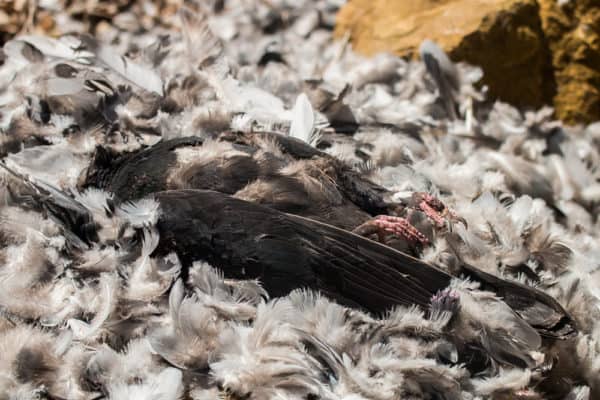
The other thing I noticed was an obvious ethical double standard for my duct-taped, maglite optics. For example, if someone excercises their right for "pest control" and shoots a bunch of pigeons using a light to see them in a dark area, then tosses the carcasses in the woods for the cayotes, which most people would do, let's be honest here, that's apparently fine. But, the moment I want to use the same method to gather pigeons for meat it's wrong? Give me a break.
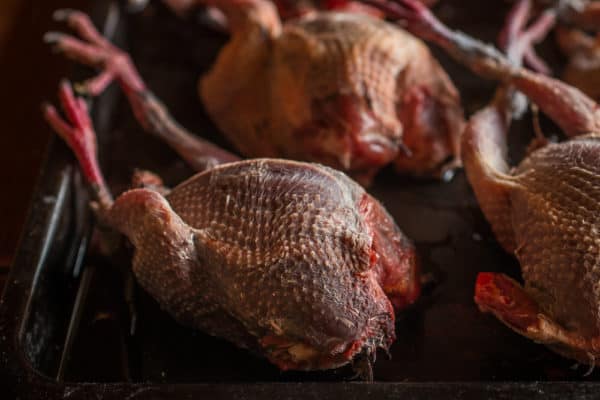
Ok, enough ranting. With my first harvest of pigeons I wanted to make something special out of them, but not just seared squab breast with a side of wee thigh to chew on, I wanted to pluck and use the whole bird. The answer came to me while reading the Little House on the Prairie Cookbook, (an excellent pioneer recipe resource) when I noticed a similar recipe for blackbird pie, which, if you were wondering, were actually starlings.
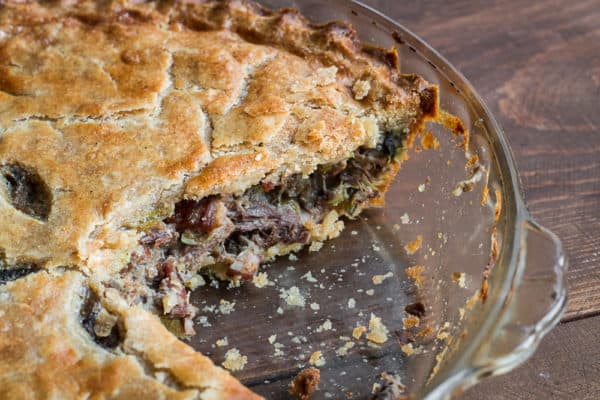
Plucking pigeons is optional
The pie is actually pretty simple: take some plucked birds, simmer them until tender, pick the meat, make a thick gravy from the cooking broth, and bake it in a pastry crust. The use of the whole bird, stock, offal and all, to me, reeks of history, and resourcefulness. And, although it's a little work to pluck pigeons, it goes rather quick if you skip the wings, which I was doing by clipping them off with a shears, that being said, plucking the birds is optional, and you can just discard the skin and feathers if you want.
The end result? Fantastic. That being said, It's hard to make braised poultry scented with porcini baked in a crust taste bad, and the squaby pie tastes a bit like duck, more or less. It could be a great centerpiece at your next Rennaissance Festival gathering, with a horn full of the village ale, followed by a dessert of medlars.
Pigeon Pie
Ingredients
For the filling
- 5 whole pigeons plucked or not, offal reserved
- Water to cover the pigeons, about 2 qts
- Aromatics for cooking the pigeon like carrot, onion, celery and a dried bay leaf (optional)
- ½ cup dry white wine optional
- 1.5 teaspoons fresh chopped thyme plus a few extra sprigs for cooking the squab
- ¼ cup cognac
- 20 grams dried bolete mushrooms like porcini
- 1 medium leek washed and trimmed, cut into small dice to yield 4 oz
- 2 ounces slab bacon preferably homemade, cut into small dice
- ¼ cup bacon drippings or lard
For the crust
- 2 cups flour preferably a blend of all purpose white and whole wheat
- ½ cup sour cream
- 5 tablespoons chilled lard or butter chopped
- ½ teaspoon kosher salt
Instructions
- Put the pigeons, their offal, aromatics, a few sprigs of thyme and white wine into a stock pot, add water barely to cover, then cover the pot, bring to a simmer and cook on low for 2.5 hours or until the legs move easily from the pigeons. Meanwhile, toast the porcini in an oven until lightly browned and toasted, about 10 minutes at 350, then cool and reserve.
- Remove the pigeons from the pot, and add the porcini to the stock. Cool the pigeons until you can handle them, then remove the skin and pick the meat, leaving the breasts whole. Reserve all the meat and offal. Meanwhile, begin reducing the braising liquid with the mushrooms until 2 cups remain. Remove the mushrooms then strain the stock and reserve both separately.
- Render the bacon over medium-high heat until the fat starts to render, then add the leeks and cook until soft, stirring occasionally, about 10 minutes. Deglaze the pan with the cognac, cook for a few minutes more to remove the alcohol, and reserve.
Pigeon Gravy
- Melt the drippings or lard in a pan, then add the flour when hot and cook until thick, whisking constantly. Gradually add the pigeon liquid until you get a very thick gravy, season to taste with salt and pepper. The sauce should look more like a binding agent for the filling as opposed to a sauce.
Baking
- Coarsely chop the pigeon breast meat and offal, add the mushrooms, leg meat, fresh thyme, cooked leeks and bacon. Finally, toss with the sauce, double check the seasoning, adjust as needed, then pack into the pie crust, top with the lid, crimp the edges well, brush the whole thing with egg beaten well without water, bake at 400 for 15 minutes then 350 for 15 minutes, remove from the oven, cool for 10 minutes and serve.
Notes
To pluck or not?
If you don't want to pluck your pigeons it's fine-they're small and time consuming. You can simmer them without browning and you'll still get a good flavor.Crust
Feel free to substitute your favorite pie crust for the crust in the recipe. It's also fine to only do a top crust since this is a wet pie the bottom crust will not be crisp.Nutrition
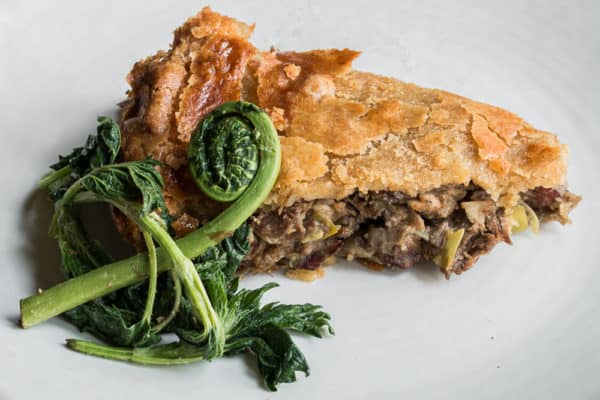

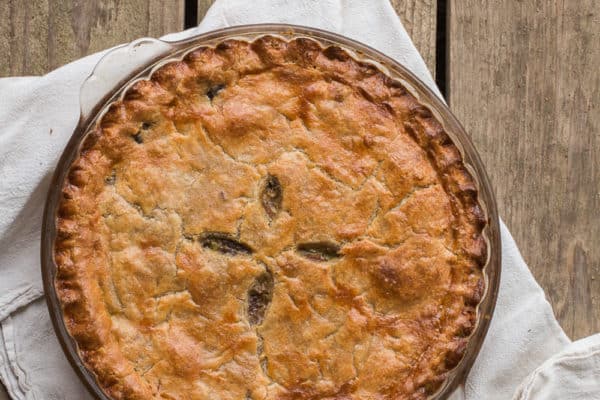

Jean
The thickening agent can be a challenge if one does not want to use wheat flour. Tapioca comes to mind as well as Arrowroot. There is potato starch too, but I have only tried Tapioca and Arrowroot. (Arrowroot is hard to mix without it gumming the broth up.) If I am remembering correctly, one or the other might not take well to over cooking. What I came on to say though, was . . . In my Greek cookbook, they use "Rusk" crumbs sprinkled on the raw pie dough in an Apple pie recipe. I believe it is to absorb moisture, most likely to keep the bottom crust more dry.
"Rusk" crumbs I believe are similar to bread crumbs. It is my understanding that they sometimes are double baked bread with an outcome of being extra crunchy.
Just some ideas on keeping that bottom crust from becoming soggy. Although over doing the thickening agent goes a longs ways in helping to keep the pie's filling nice and thick. I am having varied results, but, practice makes perfect and that is my aim.
Alan Bergo
Hey Jean thanks for chiming in. Rusk crumbs on the crust is a great old fashioned trick. It's also fine to just make this like a pot pie.
Jean
Turned out way better then expected!
Alan Bergo
Glad to hear it. Remember the double crust is optional. It's much easier to just make a top crust for most people.
Jean
I was in a hurry and only used a top crust this time. What would you do if you wanted to make a pigeon pie for someone who could not eat mushrooms?
Thank you in advance! Jean
Alan Bergo
You can just skip the mushrooms. Add some sautéed onions, Cooked leeks, sautéed fennel or something similar instead.
Jean
Will miss the mushrooms but the ideas you gave are great and will lead to other ideas as well. Thank you so much! Looking forward!
Jean
Ok . . . So, straining the broth makes it easier to mix in the thickener. I used arrowroot. Was out of tapioca. Family member off wheat products at this time. I really goofed up the recipe, but, its in the oven. Expecting the worse, but, hoping for the best. I did add in some dehydrated leeks to take the place of the leeks that were strained out. (because I put dehydrated leeks in the pressure cooker with the rest of the veggies etc.) So . . . I really messed up big time but there are always second chances (and third if I need them) Right?
And I did end up reducing the stock to 2 cups. (Ended up being 1 cup after I strained it) Thank you for this recipe!
Jean
Hi,
Could one:
1 cook the birds in a pressure cooker with 2 cups water (cook 30 minutes)
2 remove meat and set aside
3 put bones with remaining liquid, plus ACV and 4 cups water into pressure cooker to make bone broth. (cook 30 minutes) strain bones out.
4 Put finished bone broth, dried mushrooms, cooking wine, seasonings, herbs, leeks into pressure cooker and cook 5-8 minutes.
Next step is to reduce liquids down to 2 cups I guess. I didnt want to do this at first because I thought that I would loose the goodness the pressure cooker created. But, maybe not. I just dont want to lose the flavor by steaming it away.
"Remove the mushrooms then strain the stock and reserve both separately."
In Number 2, Why is the stock strained at this point?
Thank you,
Jean
Someone from Africa
You are really bad at taking pictures. You made it look disgusting. It's not eating the pigeons that is wrong, it's that you had to flaunt it and in an ugly way. You know what they say about men who have to show off their weapons, small Wee WEE!!
Alan Bergo
It's easy to throw tomatoes into the arena when you sit in the bleachers.
David
EXCELLENT and skilfully executed come back.
stephen e. hansen
no vegan thoughts???
Alan Bergo
I'd recommend using mushrooms and following my recipe for the chanterelle torte here if you're looking for a vegan option. That being said, there's no substitute for a delicious pigeon. Mushroom Torte
Mark
Pigeon plucking is a lot of work.
In Europe we tend to just take the breast meat off (it's probably 80% of the usable total) and do without the carcass, legs and such. The offal can be used with this method.
With a little practice it takes a minute per bird, if that.
First pluck the breast from vent to throat and down to the wings. With breast up make a transverse cut perhaps an inch long just below the point of the breastbone, deep enough to get two fingers under it into the body cavity. Hold the legs down with one hand and with two fingers of the other just lift the breastbone and pull it towards the head. It will seperate from the carcass along the sides. Then take a knife and extend the seperation on both sides to the point where the whole breast is 'pivoting' taking care to leave as little meat behind as possible. Snip through that point with kitchen shears to release the breastbone intact with both breasts on it.
The meat can easily be removed from the breastbone if required, or left as is and cooked on the bone which presents nicely on the plate.
Alan Bergo
A good tip. Thanks for sharing. I don't pluck them often.
Wren
We have added pigeons to our homestead as a meat source this year--we're working on building up our flock before harvesting them. I should mention, they are probably the easiest birds I've ever raised--far easier than even chickens. AND YES. They are absolutely gorgeous birds. Anyone who sees them only as rats-with-wings has never had the opportunity to watch one preen itself in the sunlight. You may be one of the (very) few websites I've found that can see that.
I haven't butchered one yet--they are relatively new, and I am waiting until their numbers are higher. When you raise them yourself, 5 birds seems like a lot, haha!. I'm sure they'll continue breeding like...well, pigeons, and I'll have this recipe bookmarked so I can make a pork-free adaptation for when the day comes.
Alan Bergo
Hey Wren, thanks, yeah I really enjoy the pigeons. Just yesterday I was admiring them swooping in and out of the barn. Beautiful birds, good on you for raising some--I can imagine it being really gratifying, and easier than others. A
Carla
Are the livers and hearts chopped and added to the pie or just used for flavoring the stock? We hunt doves every year and occasionally bag a pigeon as well. This pie sounds delicious! And I agree, indiscriminate killing and wasting does not a hunter make.
Thanks for the recipe!
Alan Bergo
Thanks Carla. I can see that was clear as mud. The offal is simmered with the whole birds, then chopped and mixed with the meat and used in the pie. Pigeon offal is very mild.
Micheal Dean
! HA! ...saved to my '!EAT!REAL!FOOD' sub-folder...reminds me of a recipe from the Great Graham Kerr that I used nearly 50 years ago. Kerr called for chicken, which I made, but also with cornish game hen, and later ptarmigan, a really stupid but tasty bird like quail or...mmmm, pigeon. It wasn't a pie....mmmm, pie, meat pie...
Now I really must stop drooling on my key board and finish my lunch of tortellini.
Alan Bergo
I've always wanted to try ptarmigan.
David
Failing to use what you hunt, fish or fowl, and kill is an offense under Ontario's Natural Resources Regulations. A proper encouragement to do the right thing. Squab ... yum.
Sam Schaperow
That sounds like a good use of pigeon. Do you find it makes somehow a much taste your or at least different flavored pie than if you were to use a commercially more available kind of poultry?
Alan Bergo
The pigeon is very flavorful, like if you made the pie from duck. You could sure use pheasant, or substitute chicken thighs. Commercially with pigeons this pie would cost 120$ + for the meat alone. Chicken thighs are the best subsitute economically.
Ellen Zachos
Love this idea! And I've got pellet gun...now to find me some pigeons.